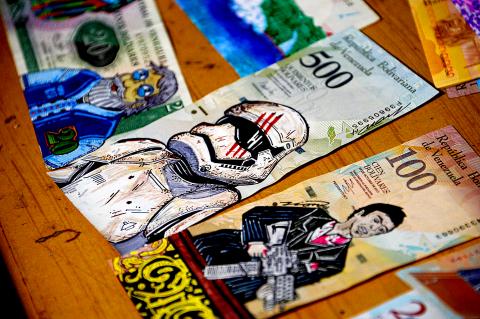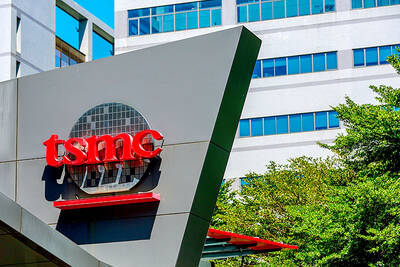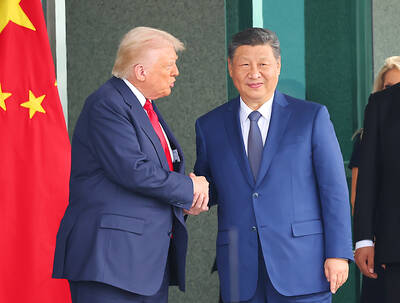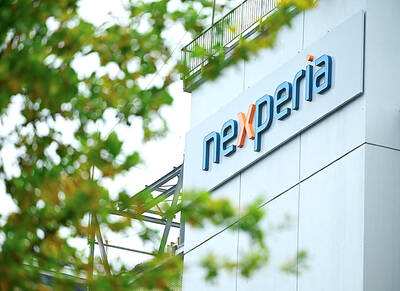Venezuela’s currency has lost so much value that people simply throw away their small bills — they are virtually worthless anyway.
Enter Wilmer Rojas, 25, who scoops them up off the street, uses an origami-like folding technique, a needle and thread to make handbags with an eye to selling them — maybe even abroad, where people have real money.
Rojas can use as many as 800 bills to make such a purse. If you add up the face value of all that money, it is enough to buy only half a kilogram of rice. Rojas and his wife have three kids to feed, and another is on the way.

Photo :AFP
“People throw them away because they are no good to buy anything. No one even accepts them anymore,” Rojas told reporters outside a subway station, where he also sells coffee and cigarettes in addition to his unusual bag-weaving work.
Meanwhile, inflation in the oil-rich, cash-poor economy churns on and on: Since August last year, the bolivar has lost 87 percent of its value against the euro. Inflation this year is forecast by the IMF to come in at a staggering 13,000 percent.
With two, five and 10-bolivar notes, “you can’t even buy a piece of candy,” Rojas said, explaining how he used 400 such bills to make a smaller handbag.
Rojas then pointed to a queen’s crown he made out of bolivar notes.
“Here there are about 50,000 bolivars [US$2], which is maybe enough for a pack of cigarettes,” he said.
Rojas said he learned his craft from another makeshift artist.
“You can use magazine paper or newspaper pulp, but currency notes are better because they are not worth anything, they are all the same size and you don’t have to waste time cutting them,” Rojas said.
He hopes to start selling his creations soon, but he fears that Venezuela’s economic crisis might foil his plans.
“Here, people barely have enough to put food on the table and are not going to shell out money for something that required a lot of work,” he said.
In downtown Caracas, other hungry artisans are selling woven bags like these. They get as much as 300,000 bolivars for one of them. That would buy 1 kilogram of meat.
That Venezuela’s currency is being used as play money is the ultimate expression of how much value it has lost, economist Tamara Herrera said.
With 1,000 two-bolivar notes that nobody wants, Jose Leon, a 26-year-old designer, began a protest on Instagram in 2016 that featured doctored notes and the hashtag #venezueladevaluada, or devalued Venezuela.
Deadpool, the anti-hero in the Marvel comics, was the inspiration for his first work on currency notes, using his face to replace that of independence hero Simon Bolivar.
Leon has also drawn the faces of Star Wars characters over that of Bolivar and other famous Venezuelans pictured on the notes.
Leon’s customers live abroad and pay him up to US$20 per piece of “money art.”
“With a bit of Wite-Out and some pens, I can raise the value of the currency by nearly 5,000 percent,” Leon said at his workshop in San Cristobal, a city on Venezuela’s border with Colombia.
Leon is doing well with his art, but Rojas is still struggling to make money — in the meantime, he is using notes to make a carnival costume for his daughter.
“These things are no good for buying anything. At least I am putting them to good use rather than throwing them away,” Rojas said.

RUN IT BACK: A succesful first project working with hyperscalers to design chips encouraged MediaTek to start a second project, aiming to hit stride in 2028 MediaTek Inc (聯發科), the world’s biggest smartphone chip supplier, yesterday said it is engaging a second hyperscaler to help design artificial intelligence (AI) accelerators used in data centers following a similar project expected to generate revenue streams soon. The first AI accelerator project is to bring in US$1 billion revenue next year and several billion US dollars more in 2027, MediaTek chief executive officer Rick Tsai (蔡力行) told a virtual investor conference yesterday. The second AI accelerator project is expected to contribute to revenue beginning in 2028, Tsai said. MediaTek yesterday raised its revenue forecast for the global AI accelerator used

Taiwan Semiconductor Manufacturing Co (TSMC, 台積電) has secured three construction permits for its plan to build a state-of-the-art A14 wafer fab in Taichung, and is likely to start construction soon, the Central Taiwan Science Park Bureau said yesterday. Speaking with CNA, Wang Chun-chieh (王俊傑), deputy director general of the science park bureau, said the world’s largest contract chipmaker has received three construction permits — one to build a fab to roll out sophisticated chips, another to build a central utility plant to provide water and electricity for the facility and the other to build three office buildings. With the three permits, TSMC

TEMPORARY TRUCE: China has made concessions to ease rare earth trade controls, among others, while Washington holds fire on a 100% tariff on all Chinese goods China is effectively suspending implementation of additional export controls on rare earth metals and terminating investigations targeting US companies in the semiconductor supply chain, the White House announced. The White House on Saturday issued a fact sheet outlining some details of the trade pact agreed to earlier in the week by US President Donald Trump and Chinese President Xi Jinping (習近平) that aimed to ease tensions between the world’s two largest economies. Under the deal, China is to issue general licenses valid for exports of rare earths, gallium, germanium, antimony and graphite “for the benefit of US end users and their suppliers

Dutch chipmaker Nexperia BV’s China unit yesterday said that it had established sufficient inventories of finished goods and works-in-progress, and that its supply chain remained secure and stable after its parent halted wafer supplies. The Dutch company suspended supplies of wafers to its Chinese assembly plant a week ago, calling it “a direct consequence of the local management’s recent failure to comply with the agreed contractual payment terms,” Reuters reported on Friday last week. Its China unit called Nexperia’s suspension “unilateral” and “extremely irresponsible,” adding that the Dutch parent’s claim about contractual payment was “misleading and highly deceptive,” according to a statement